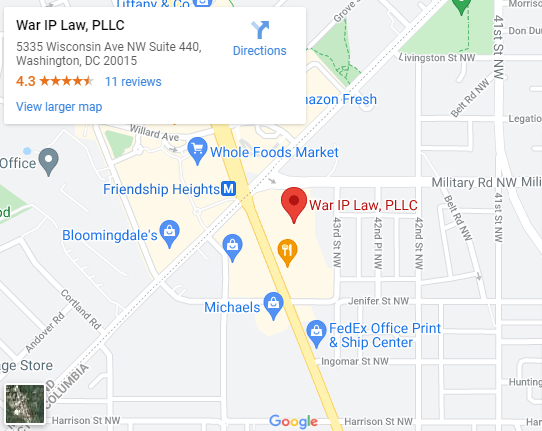Receiving a Section 2(e)(1) refusal to a trademark application typically means that the United States Patent and Trademark Office (USPTO) has determined that the mark is merely descriptive of the goods or services listed on the application. Merely descriptive trademarks, while often appealing to business owners, are not eligible for federal trademark registration through the USPTO. Although the “merely descriptive” trademark refusal is quite common, it is also generally challenging to overcome. If you have received a rejection, especially a merely descriptive rejection, contact an intellectual property attorney with War IP Law PLLC by calling us at (202) 800-3754 to learn more about your legal options and what your next steps as a trademark owner should be.
An Overview of Merely Descriptive Marks
Although there are various reasons why a trademark application may get rejected, one of the top reasons for a trademark rejection is “mere” descriptiveness. According to the Trademark Manual of Examining Procedure (TMEP), a trademark is generally deemed “merely descriptive” if it describes a quality, characteristic, ingredient, function, purpose, feature, or use of the applicant’s goods or services in the trademark application.
The characteristic common feature of marks in this category is that they simply announce some aspect of a good or service, rather than clearly identifying or distinguishing the source of the service or the good. The USPTO provides some examples of merely descriptive trademarks. These examples include:
- Using the word “CREAMY” for yogurt, as it only describes one of the qualities of yogurt
- Describing potpourri as “APPLE PIE” since it is only describing the scent
- A “bed and breakfast registry” for lodging reservation services as it only describes the purpose of the services
Why Do Merely Descriptive Marks Get Rejected?
When trademarks are merely descriptive, they will not receive the protections conferred by registration through the USPTO. The rationale behind these rejections is to ensure fair competition. All participants in the marketplace have a right to use dictionary words to describe their own offerings. Giving one trademark owner exclusive rights to a merely descriptive mark could unfairly hinder competitiveness in the sale of similar services or goods.
What Are Deceptively Misdescriptive Trademarks?
When a trademark is considered deceptively misdescriptive, it means that the term or design used to identify an item erroneously or falsely describes some characteristic of that good or service. So-called “misdescriptive” trademarks also cannot be registered, as they are still treated in the same way as a descriptive trademark application, even though they do not accurately describe the traits of the product.
There are generally three factors that a USPTO will consider when trying to determine if a trademark is deceptively misdescriptive. If all three questions produce the answer “yes,” the examining lawyer will likely reject the application as being deceptive.
- Is the composition, quality, function, or character of the goods misdescriptive?
- Will customers believe that the misdescription actually describes the actual product characteristics?
- Would an individual’s buying decision be affected by the misdescription?
The Difference Between a Merely Descriptive Mark and a Suggestive Mark
The layperson submitting an application to register their trademark may sometimes confuse descriptive marks with suggestive marks. However, there are significant differences between these two terms. Suggestive marks require thought, imagination, or perception to determine the nature or the quality of the goods, and as a result they do receive moderately strong protection from the USPTO. In comparison, a descriptive mark allows someone to make conclusions without having to put any effort into it.
Overcoming a Mere Descriptiveness Rejection
Overcoming a rejection based on merely descriptive grounds can be difficult, but it may not be impossible in every case. The following strategies are frequently used by intellectual property (IP) attorneys when trying to overcome merely descriptive trademark rejections on behalf of their clients:
Arguing That the Trademark Is Suggestive
In some instances, a trademark lawyer faced with a “merely descriptive” rejection to a client’s application for trademark registration may argue that their client’s trademark does not directly describe the goods or services but rather is suggestive since consumers will need to infer or guess the intended connected meaning. Suggestive marks are considered distinct because they allow room for ambiguity and require some imagination or thought on the part of the consumer to understand the implied features or characteristics of the good or service. As a result, suggestive trademarks can often be registered with the USPTO.
Providing Expert Assessments To Help Overcome the Rejection
Another way legal professionals try to fight a mere descriptiveness rejection is by soliciting expert opinions. Obtaining an affidavit from an expert supporting the trademark can help overcome a merely descriptive rejection, as it may provide the USPTO examiners with enough compelling evidence to change their minds. However, in this scenario it is important to choose an expert who has experience and solid credibility, as well as one who is able to detail and discuss the trademark’s benefits.
Arguing for Additional Meanings
Intellectual property lawyers may also argue that the trademark encodes multiple meanings, invites multiple interpretations, or could be considered a double entendre. Any of these arguments may help to overcome a merely descriptive rejection by showing that the mark may have other relevant and perceived meanings.
Seeking Registration on the Supplemental Register
Some lawyers may also try to seek registration of a client’s trademark on the Supplemental Register instead of the Principal Register. Registration on the Supplemental Register is generally an admission by the trademark owner that the trademark is not distinctive enough to be placed on the Principal Register. However, trademarks on the Supplemental Register that are descriptive could gain distinctiveness over time, and so theoretically might become eligible for transfer to the Principal Register eventually.
Adjusting and Reapplying
Finally, some attorneys may advise their clients to add new, distinctive elements to their trademark and reapply for registration so the mark has a better chance of getting approved. To better understand these options and learn more about how to handle a merely descriptive rejection, reach out to an experienced intellectual property lawyer at War IP Law PLLC today.
Learn More About Merely Descriptive Rejections
At War IP Law PLLC, our legal team offers a wide range of legal services to companies, individuals, and inventors related to intellectual property, including trademarks, patents, and copyrights, as well as litigation involving the infringement of any of these intellectual property rights. Our goal is to help clients identify, register, and assert their IP rights while defending them against infringement claims. If you want further information about merely descriptive rejections or want to explore your legal options in such situations, contact War IP Law PLLC. You can call us at (202) 800-3754 to speak with a member of our legal team.






